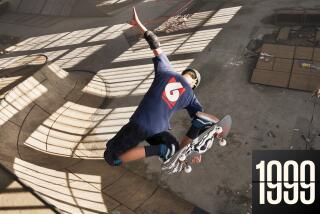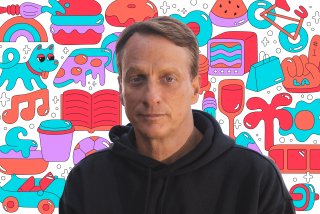Tony Hawk: Still relevant at 40
- Share via
He’s a video game star, radio show host, ringleader of a traveling show. There’s roller coasters and phones bearing his name, a clothing line and watches at Kohl’s, drapes and bed linens at Target.
He runs a charitable organization and a film production company, has a corporate office in Southern California. He has appeared on Nickelodeon and the Disney Channel, posed for the cover of MAD Kids magazine, given big for Oprah, proven he’s not smarter than a fifth-grader.
He is Tony Hawk, master marketer, action sports mogul, iconic figure in the same league as Michael Jordan and Tiger Woods.
Now 40, the skateboarding pioneer and innovator is as relevant as ever because he never veered from what got him here: riding a skateboard.
“I do wear a lot of different hats,” Hawk said. “But no matter what I do or what I get involved with, in the end I just want to be known as a skater.”
Hawk’s ride to the top started in Southern California, where his older brother, Steve, gave a hyper, 9-year-old a thin, plastic skateboard.
Blessed with natural ability and an ultra-competitive nature -- he once became so distraught from striking out in a Little League game that he hid in a ravine -- Hawk spent hours on homemade ramps built by his father, Frank, breaking down the mechanics of a trick, honing it into perfection.
Hawk’s determination and physical abilities allowed him to do things on a skateboard others couldn’t even imagine, the flying, whirling Birdman changing the dynamics of his sport seemingly with each trip down the ramp.
Skating wasn’t exactly a lucrative sport in the early days -- he was put on a $5 Taco Bell allowance by his first wife -- so Hawk looked for other ways to cash in.
He started a skateboard company, Birdhouse Projects, in 1992 and built his empire from there, riding skating’s rising popularity in the mid-90s to create an assemblage of video games, clothing lines and skating gear that has reportedly earned him more than $100 million.
Even if Hawk never skated again, his legacy would ride on.
“Tony is such an iconic figure in these sports and that’s not going to change,” said Wade Martin, general manager of the AST Dew Tour. “The Tony Hawk brand still lives in so many ways, from the HuckJam to the video games to clothing and apparel, becoming irrelevant certainly is not a concern of his.”
Hawk didn’t build this empire by accident. He’s as meticulous off his board as he is on it, carefully cultivating his image so it doesn’t clash with the skateboarding community.
Looking at every angle, Hawk breaks down a business decision as if it were a new trick he was trying to master, making sure it makes sense financially and, more importantly, meshes with skateboarding culture.
He has turned down numerous commercial deals for companies and marketing approaches he thought were too cheesy, instead pairing with products -- Jeep, Quiksilver clothes, T-Mobile Sidekick -- that appeal to the skating crowd.
It was still a risky path.
Since its early days, skateboarding has been anti-establishment, in the same vein as the music industry: go mainstream, get dubbed a sellout.
Hawk did it in a way that was innocuous, his meticulous choices of products seeming like a natural progression rather than a betrayal of skater values.
It didn’t take skaters long to realize the opportunities corporate money could provide -- bigger and better ramps, more contest prize money, better equipment -- and now it’s no big deal when action sports stars like Shawn White and Ryan Sheckler crossover into the mainstream.
Though some purists call him a sellout, Hawk has changed the complexion and perception of action sports.
“He definitely cares about the integrity of action sports,” said BMX rider Kevin Robinson, who splits time between the Dew Tour and Hawk’s Boom Boom HuckJam tour.
“We all understand, too, that it takes money to make things happen. We want to take our show out on the road and showcase our talents, and the only way to do that is through corporate sponsors and such.”
More than anything, though, it’s skating that earns Hawk enduring reverence.
The man who invented some of the most difficult tricks in skateboarding retired as a competitor in 1999, not long after landing a 900 (21/2 spins) at the 1999 X Games, considered by many as the greatest trick of all-time.
Hawk didn’t stop progressing, though, creating the HuckJam in 2002 as a competitive release and a way to take action sports away from the stigma of being a sideshow to larger events like concerts and football games.
And to see Hawk at the HuckJam shows is like watching the lithesome power of a panther as it coils and pounces, that familiar, wiry 6-foot-3 frame bursting off the ramps into the sky.
Forty or 14, doesn’t matter -- the Birdman can still skate with the best.
“I don’t quit; I stay consistent in my skating,” Hawk said. “I just maintain a consistent skating level, so every time I go back I’m not afraid to try something that may be more difficult or more dangerous.”
There’s one thing about being a 40-year-old action sports star, though: it isn’t as easy as it once was.
Sure, Hawk makes it look simple, effortlessly whipping off stalefish 540s and 700s like he’s walking down the street. He’s in good enough shape that he could probably do it all day, every day, too.
The problem is that injuries are an inevitable part of action sports.
Pain that was a nuisance 15 years ago tends to a linger a bit longer when you reach middle age, and the toll of performing in 24 cities in 36 days doesn’t help. Adrenaline from the crowd and music may wash away the pain once the show starts, but it always comes back once the lights go out.
And it’s not just the wear and tear.
As a young skater, Hawk could take a week or two off, jump back on his board and not miss a beat. Now time off means spending extra time on his board, building back up to his previous level.
So does that mean that the Birdman is done, ready to hang up his helmet and close up his bag of tricks? Not just yet.
“I don’t put any ultimatums on it,” said Hawk, who has three sons and a newborn daughter. “I imagine if I was 50 that might sound ridiculous, but at the same time I never thought I’d be doing this at 40 and here I am, at a top level, and I love it. As long as I feel like I’ve got my skills in check and I walk the walk, I’m doing it on this level.”
Of course, he’s always got those other careers to fall back on.
More to Read
Go beyond the scoreboard
Get the latest on L.A.'s teams in the daily Sports Report newsletter.
You may occasionally receive promotional content from the Los Angeles Times.










